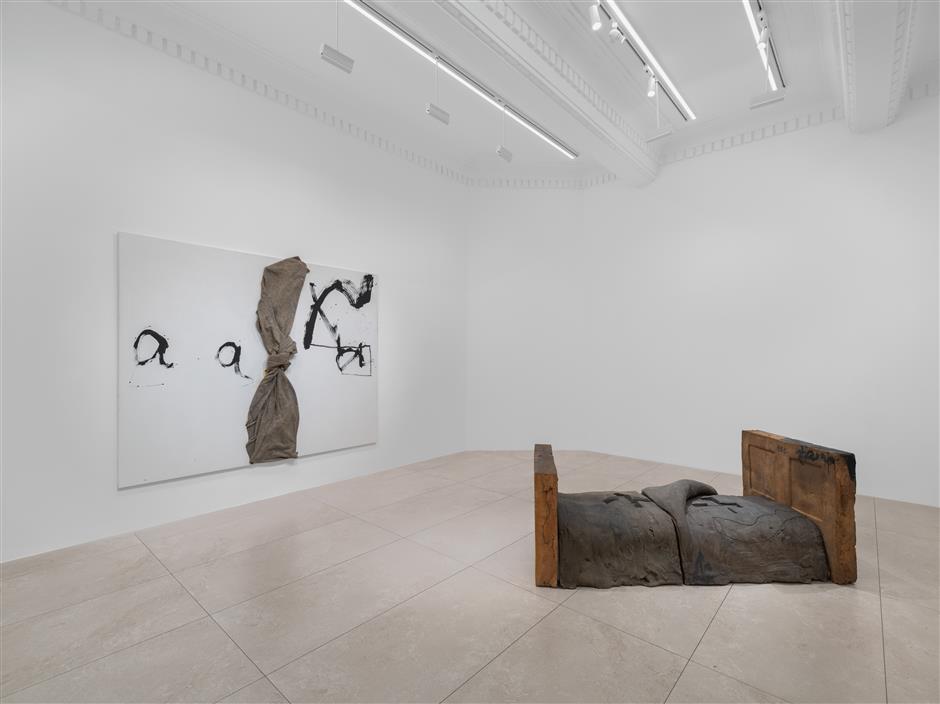Spanish artist Antoni Tàpies celebrated during 100th birth anniversary

Marking 50 years of diplomatic relations between China and Spain, this year notably coincides with the 100th anniversary of the birth of Spanish artist Antoni Tàpies (1923–2012).
Following in the footsteps of other pioneering Spanish artists such as Pablo Picasso (1881–1973), Joan Miró (1893–1983), and Salvador Dalí (1904–1989), Tàpies contributed to the advancement of modern art through theory and investigations into non-traditional materials.
The Shanghai Bund Art Center is commemorating the artist's achievements in "Antoni Tàpies: Dialogue with Objects", which opened earlier this month. Curated by Professor Zhang Zikang, director of the Central Academy of Fine Arts Museum, the exhibition encompasses two decades of the artist's career and an astonishing breadth of media.

Explorations of materiality were integral to Tàpies' practice, and he is credited with introducing mixed and unexpected media into modern art. Associated with the art informel movement, which emphasized spontaneous and intuitive creation, he often used unconventional materials in his art, such as marble dust, sand, paper, rags, straw and string, creating highly textured surfaces.
Seeing painting as an alchemical process, Tàpies believed that the combination of these seemingly ordinary materials underwent a magical transformation. Earthly substances were transmuted into something ethereal, turning the crude into the ideal.
This departure from the traditional painting's emphasis on shapes and colors allowed him to experiment with the physicality of his work. Thick materials, often resembling clay and earth, created three-dimensional surfaces that engage the viewer on a tactile level.

Symbols play a central role in Tàpies' artistic language. He integrated simple signs into his paintings, imbued with coiled thoughts and ancestral symbolism. These symbols, ranging from crosses to letters, acted as keys to various meanings, sometimes representing philosophical thoughts or the names of loved ones.
The artist frequently incorporated the symbol "A&T," representing the initials of his name, Anthony Tàpies, and symbolizing the union between himself and his wife, Teresa Barba.
While some may interpret his paintings as having an obsession with death because the sign of the cross was a recurring motif in his work, Tàpies clarified it stood for more than just Christian symbolism. It could serve as a universal symbol, expressing coordinates in space, territorial boundaries, destruction, and negation.

Tàpies has a profound connection with Eastern culture. In the 1950s, he began incorporating the thinking of Chinese Zen Buddhism and the brushwork techniques of Chinese calligraphy into his creations.
His engagement with Buddhism took a poignant turn as he contemplated the problem of pain and suffering. Influenced by Buddhist philosophy, he sought not to luxuriate in sorrow but to understand and find solutions to the inherent challenges of life. This thematic exploration added layers of meaning to his paintings, elevating them from aesthetic expressions to contemplative journeys anchored in Eastern wisdom.
In 1987, Tàpies established Spain's first and only Oriental Library in Barcelona. In his view, Eastern culture not only influenced his artistic creations but also facilitated dialogue between East and West through his works.

This period of cross-cultural exchange culminated in a retrospective exhibition which was sponsored by the China International Cultural Exchange Center and held at the National Art Museum of China in April 1989. Spurred by the 1985 new wave movement, Chinese artists and scholars alike engaged with Tàpies' practice and were impacted by modernist and post-modernist trends. Hosting young Chinese artists in his Barcelona studio in the mid-1990s, Tàpies became an active participant in shaping contemporary Chinese art and culture.
Transcendent and visionary, his practice is deeply rooted in philosophy and humanity. On the occasion of his 100th birthday, this exhibition serves as a meditation on Tàpies' artistic innovations and his indelible impact on contemporary Chinese culture and society.
Date: through January 7, 2024 (closed on Mondays)
Venue: Shanghai Bund Art Center
Address: 185, Sichuan Rd M.
Tickets: 80 yuan (US$10.98)















